201771010102 常惠琢 《2018面向物件程式設計(Java)》第12周學習總結
第一部分:理論部分:
1.集合框架中的介面:
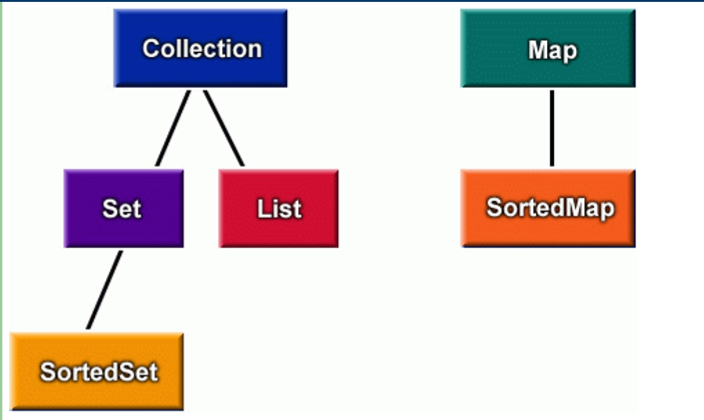
2.集合框架中的實現類:
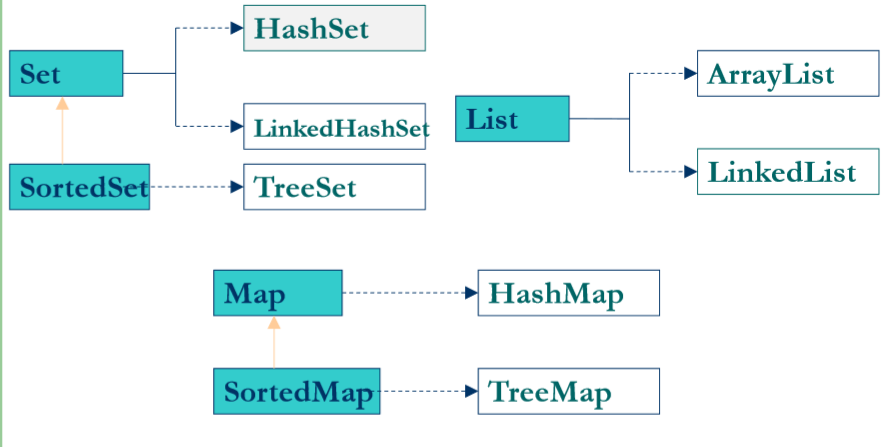
3.AWT元件(java.awt.*):
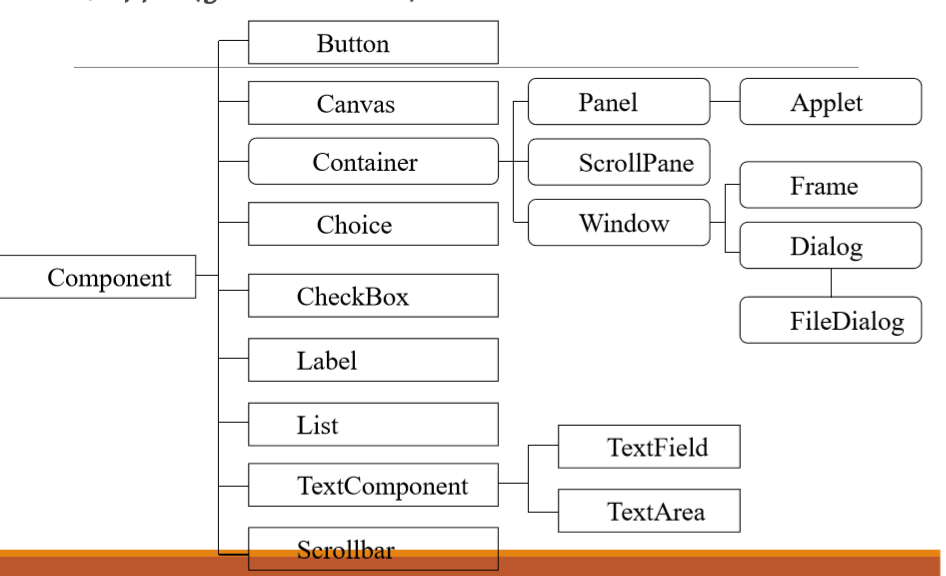
4.Swing 元件層次關係:

5.集合類的特點:
集合類特點一: 只容納物件。
集合類特點二: 容納的物件都是Object類的例項。
實驗十二 圖形程式設計:
實驗時間 2018-11-14
1、實驗目的與要求
(1) 掌握Java GUI中框架建立及屬性設定中常用類的API;
(2) 掌握Java GUI中2D圖形繪製常用類的API;
(3) 瞭解Java GUI中2D圖形中字型與顏色的設定方法;
(4) 瞭解Java GUI中2D影象的載入方法。
2、實驗內容和步驟
實驗1: 匯入第10章示例程式,測試程式並進行程式碼註釋。
測試程式1:
l 執行下列程式,觀察程式執行結果。
| import javax.swing.*; public class SimpleFrameTest { public static void main(String[] args) { JFrame frame = new JFrame(); frame.setBounds(0, 0,300, 200); frame.setDefaultCloseOperation(JFrame.EXIT_ON_CLOSE); frame.setVisible(true); } } |

1 import javax.swing.*; 2 public class SimpleFrameTest 3 { 4 public static void main(String[] args) 5 { 6 JFrame frame = new JFrame(); 7 frame.setBounds(600, 300,300, 300);//設定視窗的彈出位置和視窗的大小 8 frame.setDefaultCloseOperation(JFrame.EXIT_ON_CLOSE);//點選視窗執行關閉的操作 9 frame.setVisible(true); //設定的視窗是否可見 10 } 11 }SimpleFrameTest
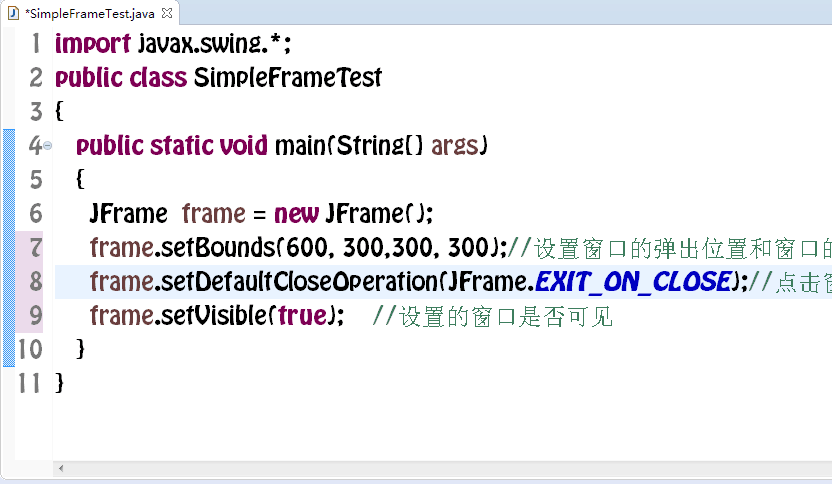
l 在elipse IDE中除錯執行教材407頁程式10-1,結合程式執行結果理解程式;與上面程式對比,思考異同;
l 掌握空框架建立方法;
l 瞭解主執行緒與事件分派執行緒概念;
l 掌握GUI頂層視窗建立技術。

1 package simpleFrame; 2 3 import java.awt.*; 4 import javax.swing.*; 5 /** 6 * @version 1.33 2015-05-12 7 * @author Cay Horstmann 8 */ 9 public class SimpleFrameTest 10 { 11 public static void main(String[] args) 12 { 13 EventQueue.invokeLater(() ->//通過執行緒開啟了一個佇列 14 { 15 SimpleFrame frame = new SimpleFrame(); 16 frame.setDefaultCloseOperation(JFrame.EXIT_ON_CLOSE); 17 //設定使用者在此窗體上發起"close"時預設執行的操作時,使用System exit方法退出應用程式. 18 frame.setVisible(true);//設定頁面是否為可見 19 }); 20 } 21 } 22 23 class SimpleFrame extends JFrame 24 { 25 private static final int DEFAULT_WIDTH = 300;//定義寬為300 26 private static final int DEFAULT_HEIGHT = 200;//定義高為200 27 28 public SimpleFrame()//建構函式 29 { 30 setSize(DEFAULT_WIDTH, DEFAULT_HEIGHT); 31 } 32 }SimpleFrameTest
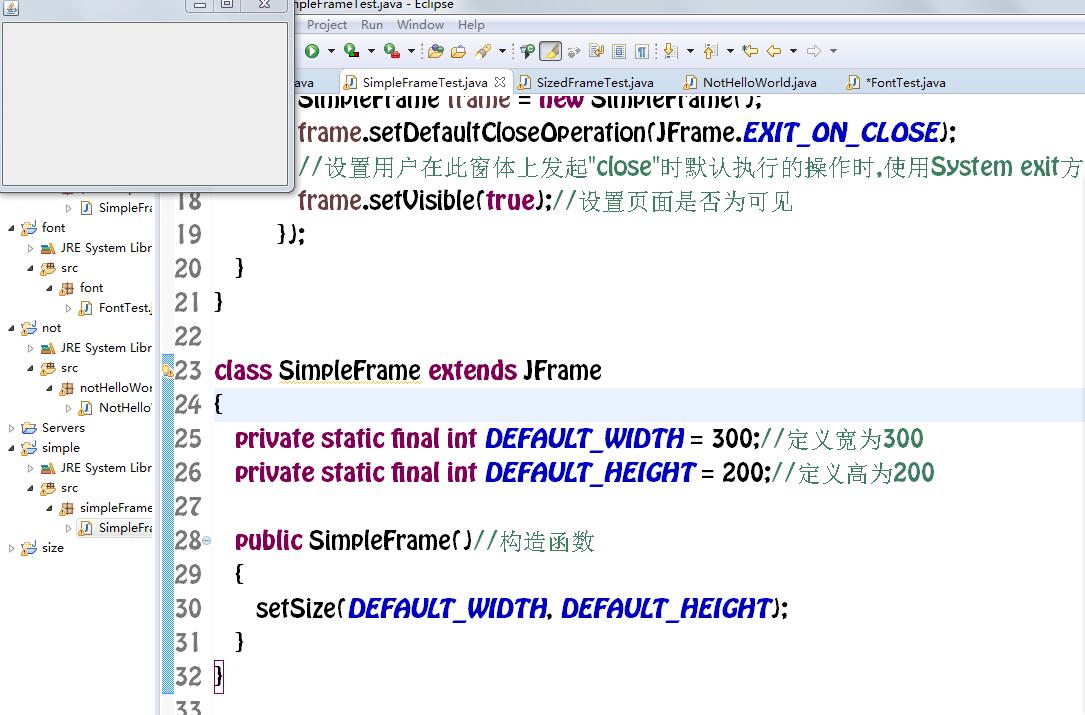
測試程式2:
l 在elipse IDE中除錯執行教材412頁程式10-2,結合程式執行結果理解程式;
l 掌握確定框架常用屬性的設定方法。

1 package sizedFrame; 2 3 import java.awt.*; 4 import javax.swing.*; 5 6 /** 7 * @version 1.34 2015-06-16 8 * @author Cay Horstmann 9 */ 10 public class SizedFrameTest 11 { 12 public static void main(String[] args) 13 { 14 EventQueue.invokeLater(() -> 15 { 16 JFrame frame = new SizedFrame(); 17 frame.setTitle("SizedFrame"); 18 frame.setDefaultCloseOperation(JFrame.EXIT_ON_CLOSE); 19 frame.setVisible(true); 20 }); 21 } 22 } 23 24 class SizedFrame extends JFrame 25 { 26 public SizedFrame() 27 { 28 // 獲取螢幕尺寸 29 30 Toolkit kit = Toolkit.getDefaultToolkit();//生成Toolkit物件 31 Dimension screenSize = kit.getScreenSize();//返回Dimension的螢幕大小 32 int screenHeight = screenSize.height;//獲得Dimension物件的寬度 33 int screenWidth = screenSize.width;//獲得Dimension物件的高度 34 35 // 設定框架寬度、高度並讓平臺選擇螢幕位置 36 37 setSize(screenWidth / 2, screenHeight / 2);//將框架的大小設定為上面取值的50% 38 setLocationByPlatform(true); 39 40 //設定幀圖示 41 42 Image img = new ImageIcon("icon.gif").getImage();//將影象設定為框架圖示 43 setIconImage(img); 44 } 45 }SizedFrameTest
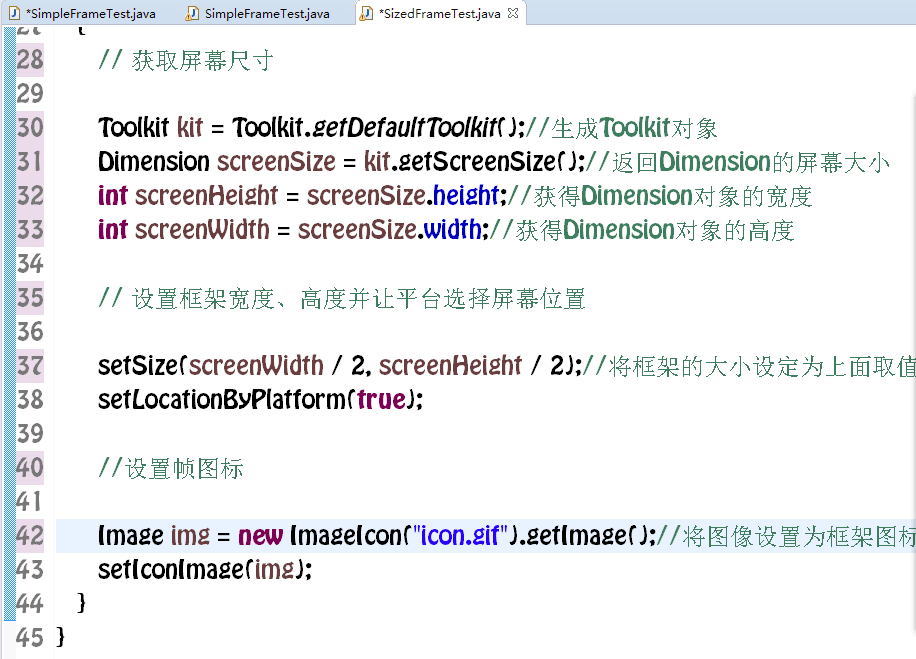
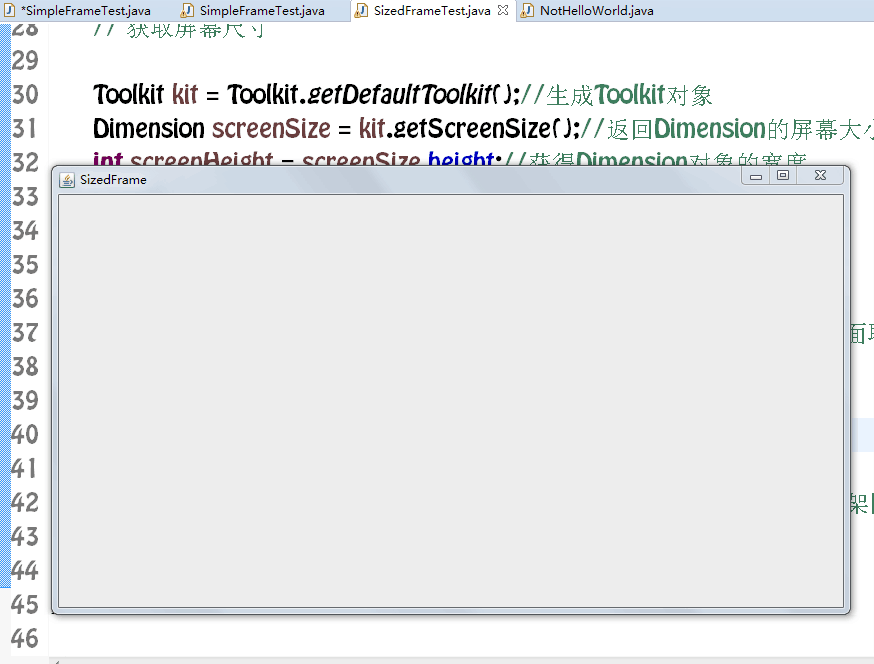
測試程式3:
l 在elipse IDE中除錯執行教材418頁程式10-3,結合執行結果理解程式;
l 掌握在框架中新增元件;
l 掌握自定義元件的用法。

1 package notHelloWorld; 2 3 import javax.swing.*; 4 import java.awt.*; 5 6 /** 7 * @version 1.33 2015-05-12 8 * @author Cay Horstmann 9 */ 10 public class NotHelloWorld 11 { 12 public static void main(String[] args) 13 { 14 EventQueue.invokeLater(() -> 15 { 16 JFrame frame = new NotHelloWorldFrame(); 17 frame.setTitle("NotHelloWorld"); 18 frame.setDefaultCloseOperation(JFrame.EXIT_ON_CLOSE); 19 frame.setVisible(true); 20 }); 21 } 22 } 23 24 /** 25 * 包含訊息面板的框架。 26 */ 27 class NotHelloWorldFrame extends JFrame 28 { 29 public NotHelloWorldFrame() 30 { 31 add(new NotHelloWorldComponent()); 32 pack(); 33 } 34 } 35 36 /** 37 *顯示訊息的元件。 38 */ 39 class NotHelloWorldComponent extends JComponent 40 { 41 public static final int MESSAGE_X = 75; 42 public static final int MESSAGE_Y = 100; 43 44 private static final int DEFAULT_WIDTH = 300; 45 private static final int DEFAULT_HEIGHT = 200; 46 47 public void paintComponent(Graphics g) 48 { 49 g.drawString("Not a Hello, World program", MESSAGE_X, MESSAGE_Y); 50 } 51 52 public Dimension getPreferredSize() { return new Dimension(DEFAULT_WIDTH, DEFAULT_HEIGHT); } 53 }NotHelloWorld
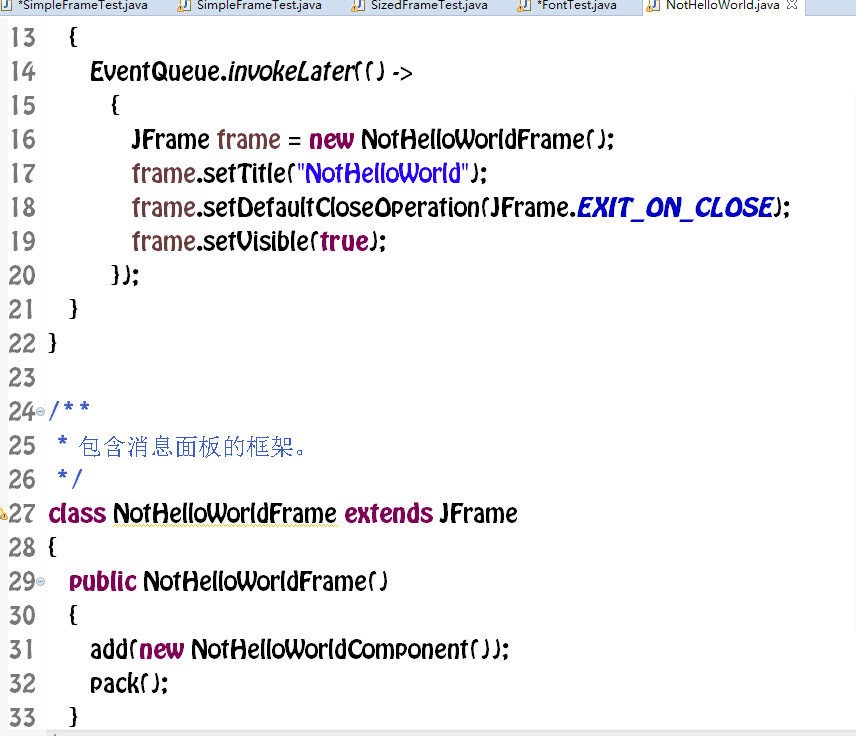
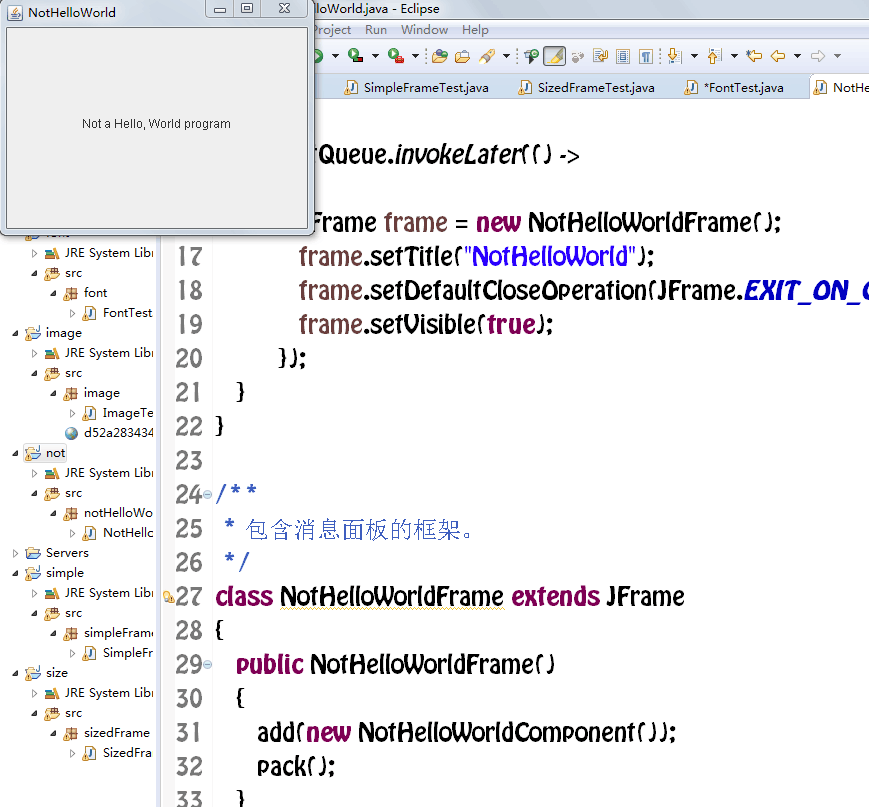
測試程式4:
l 在elipse IDE中除錯執行教材424 -425頁程式10-4,結合程式執行結果理解程式;
l 掌握2D圖形的繪製方法。

1 package draw; 2 3 import java.awt.*; 4 import java.awt.geom.*; 5 import javax.swing.*; 6 7 /** 8 * @version 1.33 2007-05-12 9 * @author Cay Horstmann 10 */ 11 public class DrawTest 12 { 13 public static void main(String[] args) 14 { 15 EventQueue.invokeLater(() -> 16 { 17 JFrame frame = new DrawFrame(); 18 frame.setTitle("DrawTest"); 19 frame.setDefaultCloseOperation(JFrame.EXIT_ON_CLOSE); 20 frame.setVisible(true); 21 }); 22 } 23 } 24 25 /** 26 *包含圖畫面板的框架 27 */ 28 class DrawFrame extends JFrame 29 { 30 public DrawFrame() 31 { 32 add(new DrawComponent()); 33 pack(); 34 } 35 } 36 37 /** 38 * 顯示矩形和橢圓的元件。 39 */ 40 class DrawComponent extends JComponent 41 { 42 private static final int DEFAULT_WIDTH = 400; 43 private static final int DEFAULT_HEIGHT = 400; 44 45 public void paintComponent(Graphics g) 46 { 47 Graphics2D g2 = (Graphics2D) g; 48 49 // 畫一個長方形; 50 51 double leftX = 100; 52 double topY = 100; 53 double width = 200; 54 double height = 150; 55 56 Rectangle2D rect = new Rectangle2D.Double(leftX, topY, width, height); 57 g2.draw(rect); 58 59 // 畫封閉橢圓 60 61 Ellipse2D ellipse = new Ellipse2D.Double(); 62 ellipse.setFrame(rect); 63 g2.draw(ellipse); 64 65 // 畫一條對角線 66 67 g2.draw(new Line2D.Double(leftX, topY, leftX + width, topY + height)); 68 69 // 用同一個中心畫一個圓 70 71 double centerX = rect.getCenterX(); 72 double centerY = rect.getCenterY(); 73 double radius = 150; 74 75 Ellipse2D circle = new Ellipse2D.Double(); 76 circle.setFrameFromCenter(centerX, centerY, centerX + radius, centerY + radius); 77 g2.draw(circle); 78 } 79 80 public Dimension getPreferredSize() { return new Dimension(DEFAULT_WIDTH, DEFAULT_HEIGHT); } 81 }DrawTest
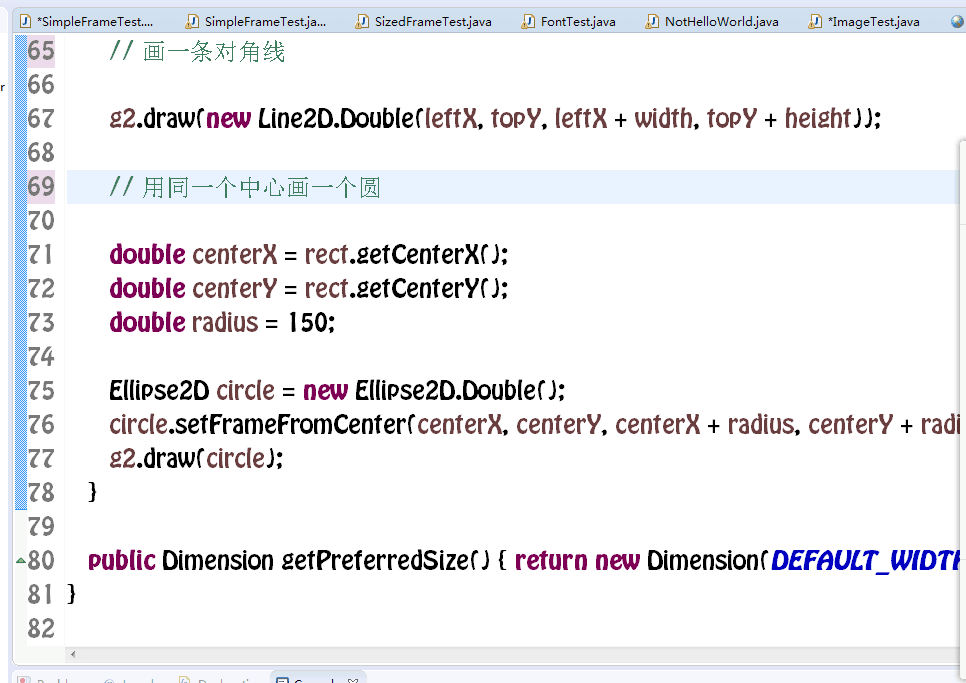
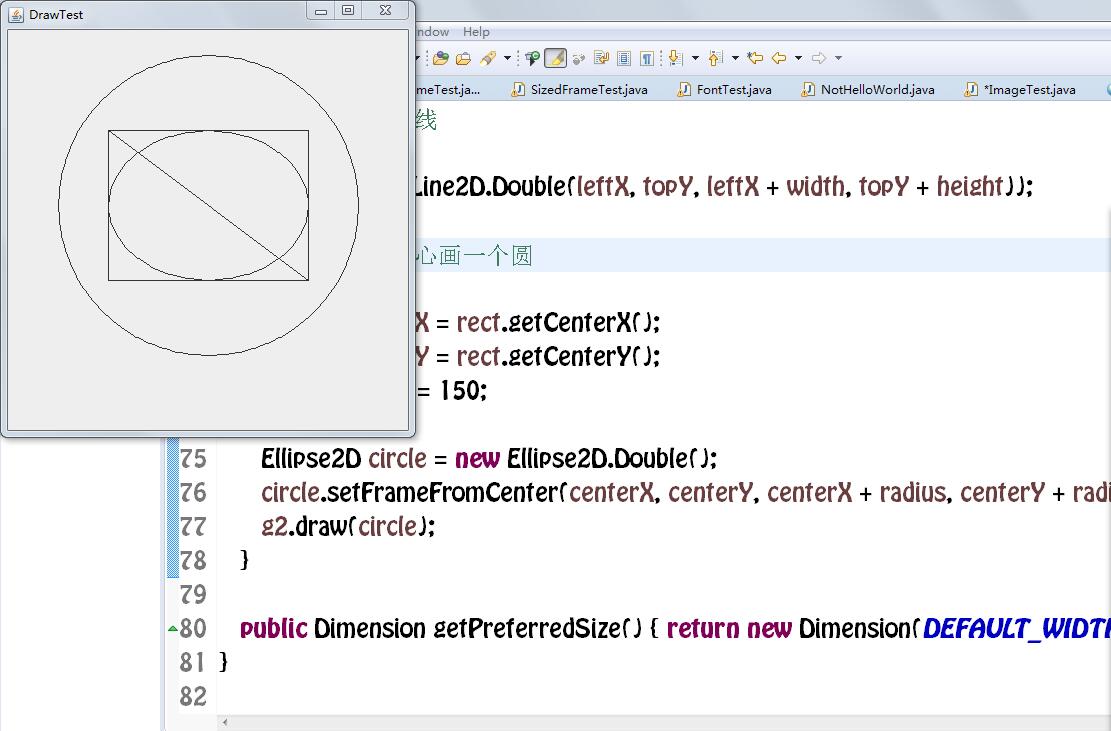
測試程式5:
l 在elipse IDE中除錯執行教材432頁-433程式10-5,結合程式執行結果理解程式;
l 瞭解2D圖形中字型的設定的方法;

1 package font; 2 3 import java.awt.*; 4 import java.awt.font.*; 5 import java.awt.geom.*; 6 import javax.swing.*; 7 8 /** 9 * @version 1.34 2015-05-12 10 * @author Cay Horstmann 11 */ 12 public class FontTest 13 { 14 public static void main(String[] args) 15 { 16 EventQueue.invokeLater(() -> 17 { 18 JFrame frame = new FontFrame(); 19 frame.setTitle("FontTest"); 20 frame.setDefaultCloseOperation(JFrame.EXIT_ON_CLOSE); 21 frame.setVisible(true); 22 }); 23 } 24 } 25 26 /** 27 * 帶有文字訊息元件的框架 28 */ 29 class FontFrame extends JFrame 30 { 31 //構造器 32 public FontFrame() 33 { 34 add(new FontComponent()); 35 pack(); 36 } 37 } 38 39 /** 40 * 在框中顯示中心訊息的元件。 41 */ 42 class FontComponent extends JComponent 43 { 44 private static final int DEFAULT_WIDTH = 300; 45 private static final int DEFAULT_HEIGHT = 200; 46 47 public void paintComponent(Graphics g) 48 { 49 Graphics2D g2 = (Graphics2D) g; 50 51 String message = "柸中有雪"; 52 53 Font f = new Font("Serif", Font.BOLD, 36); 54 g2.setFont(f); 55 56 //測量訊息的大小 57 58 FontRenderContext context = g2.getFontRenderContext(); 59 Rectangle2D bounds = f.getStringBounds(message, context); 60 61 // 設定(x,y)=文字左上角 62 63 double x = (getWidth() - bounds.getWidth()) / 2; 64 double y = (getHeight() - bounds.getHeight()) / 2; 65 66 // 增加到Y到達基線 67 68 double ascent = -bounds.getY(); 69 double baseY = y + ascent; 70 71 // 汲取資訊 72 73 g2.drawString(message, (int) x, (int) baseY); 74 75 g2.setPaint(Color.LIGHT_GRAY); 76 77 // 繪製基線 78 79 g2.draw(new Line2D.Double(x, baseY, x + bounds.getWidth(), baseY)); 80 81 // 繪製封閉矩形 82 83 Rectangle2D rect = new Rectangle2D.Double(x, y, bounds.getWidth(), bounds.getHeight()); 84 g2.draw(rect); 85 } 86 87 public Dimension getPreferredSize() { return new Dimension(DEFAULT_WIDTH, DEFAULT_HEIGHT); } 88 }FontTest
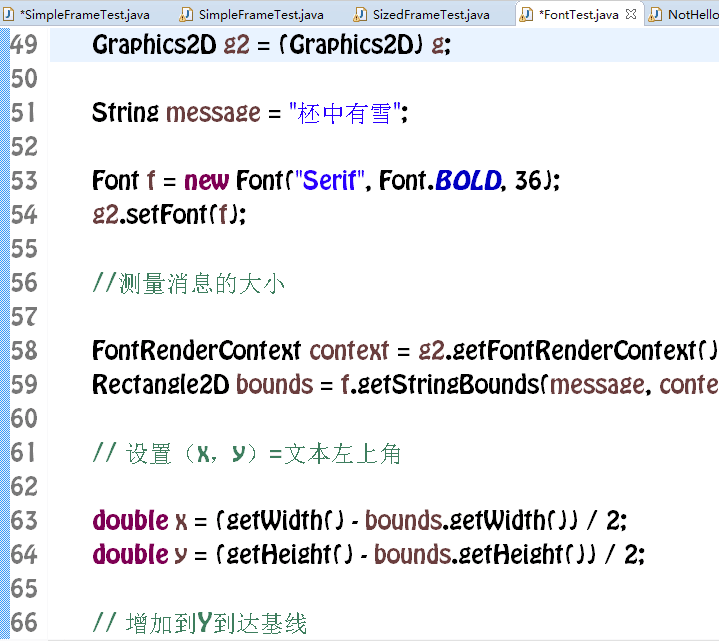
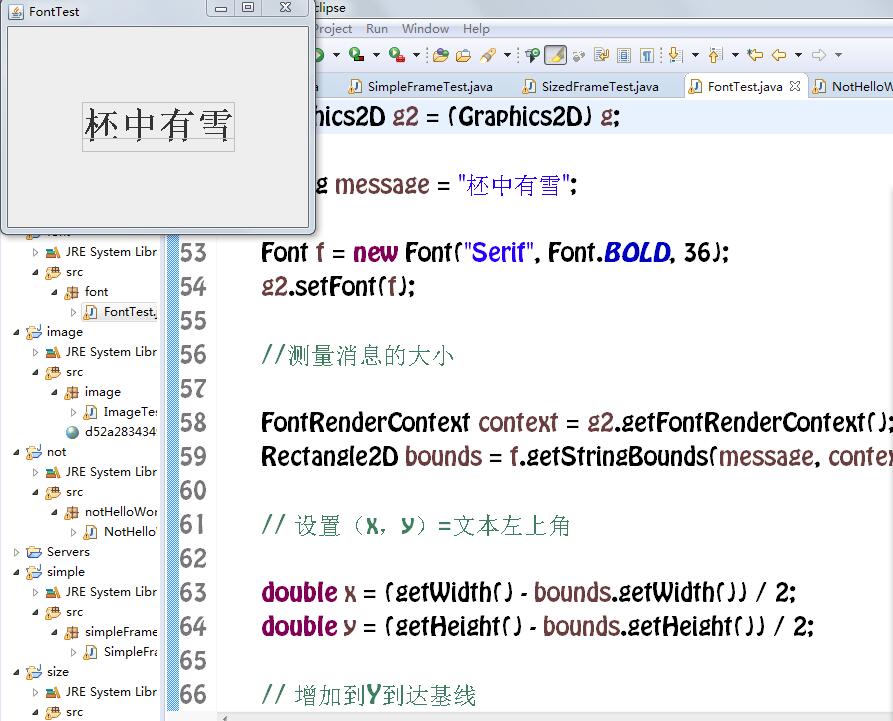
測試程式6:
l 在elipse IDE中除錯執行教材436頁-437程式10-6,結合程式執行結果理解程式;
l 瞭解2D圖形影象的顯示方法。

1 package image; 2 3 import java.awt.*; 4 import javax.swing.*; 5 6 /** 7 * @version 1.34 2015-05-12 8 * @author Cay Horstmann 9 */ 10 public class ImageTest 11 { 12 public static void main(String[] args) 13 { 14 EventQueue.invokeLater(() -> 15 { 16 JFrame frame = new ImageFrame(); 17 frame.setTitle("ImageTest"); 18 frame.setDefaultCloseOperation(JFrame.EXIT_ON_CLOSE); 19 frame.setVisible(true); 20 }); 21 } 22 } 23 24 /** 25 *具有影象分量的幀 26 */ 27 class ImageFrame extends JFrame 28 { 29 public ImageFrame() 30 { 31 add(new ImageComponent()); 32 pack(); 33 } 34 } 35 36 /** 37 * 顯示平鋪影象的元件。 38 */ 39 class ImageComponent extends JComponent 40 { 41 private static final int DEFAULT_WIDTH = 1500; 42 private static final int DEFAULT_HEIGHT = 800; 43 44 private Image image; 45 46 public ImageComponent() 47 { 48 image = new ImageIcon("blue-ball.gif").getImage(); 49 } 50 51 public void paintComponent(Graphics g) 52 { 53 if (image == null) return; 54 55 int imageWidth = image.getWidth(null); 56 int imageHeight = image.getHeight(null); 57 58 // 在左上角繪製圖像 59 60 g.drawImage(image, 0, 0, null); 61 // 在元件上平鋪影象 62 63 for (int i = 0; i * imageWidth <= getWidth(); i++) 64 for (int j = 0; j * imageHeight <= getHeight(); j++) 65 if (i + j > 0) 66 g.copyArea(0, 0, imageWidth, imageHeight, i * imageWidth, j * imageHeight); 67 } 68 69 public Dimension getPreferredSize() { return new Dimension(DEFAULT_WIDTH, DEFAULT_HEIGHT); } 70 }ImageTest
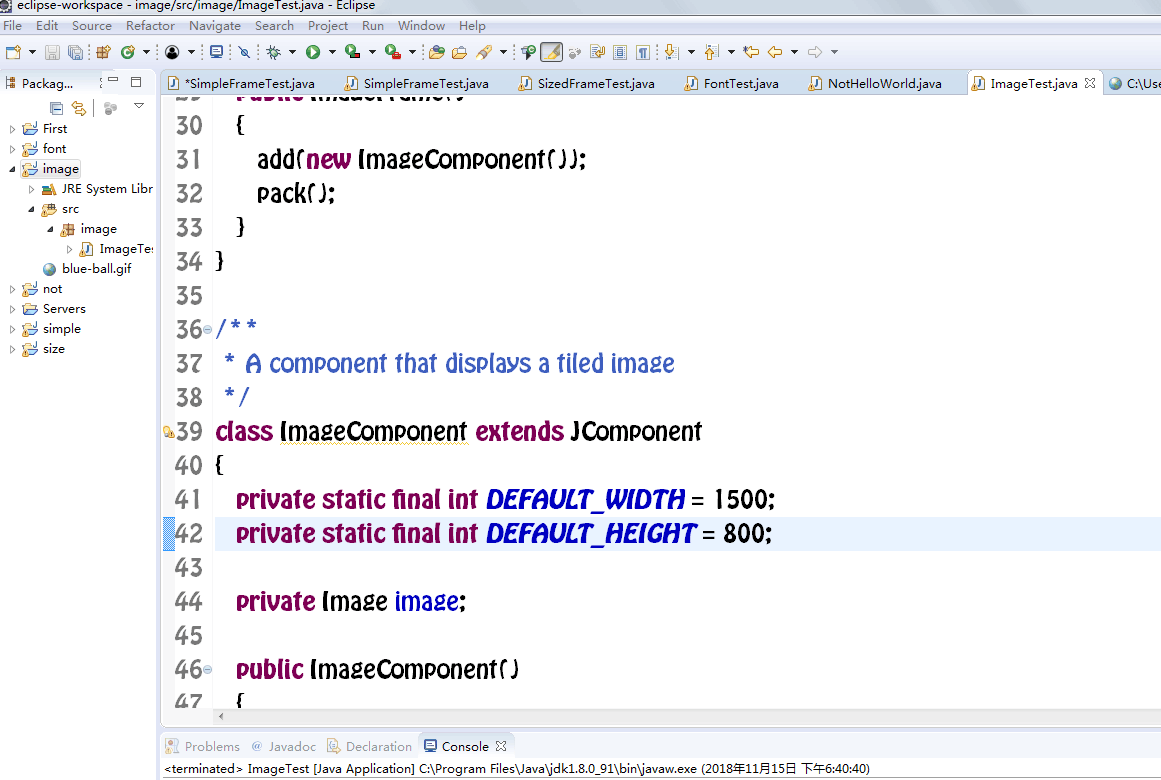
 實驗總結:
實驗總結:
System.exit( )和frame.setDefaultCloseOperation()的區別:
System.exit(0)是退出整個程式,如果有多個視窗,全部都銷燬退出。
frame.setDefaultCloseOperation()是設定使用者在此窗體上發起"close"時預設執行的操作。必須指定以下選項之一: 、
(1)DO_NOTHING_ON_CLOSE(在WindowConstants中定義):不執行任何操作,要求程式在已註冊的 WindowListener 物件的 windowClosing 方法中處理該操作。
(2)HIDE_ON_CLOSE(在WindowConstants中定義):呼叫任意已註冊的WindowListener物件後自動隱藏該窗體。
(3)DISPOSE_ON_CLOSE(在WindowConstants中定義):呼叫任意已註冊WindowListener的物件後自動隱藏並釋放該窗體。
(4)EXIT_ON_CLOSE(在JFrame中定義):使用System exit方法退出應用程式。僅在應用程式中使用。
預設情況下,該值被設定為 HIDE_ON_CLOSE
也就是說沒有設定的話,預設點關閉時只是隱藏窗體,在後臺程序中還可以看到,如果有多個視窗,只是銷燬呼叫dispose的視窗,其他視窗仍然存在,整個應用程式還是處於執行狀態。

